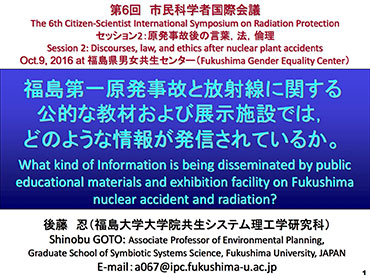講演タイトル:
福島第一原発事故と放射線に関する公的な教材および展示施設では,どのような情報が発信されているか。
Title of the speech:
What kind of Information is being disseminated by public educational materials and exhibition facility on Fukushima nuclear accident and radiation?
講演概要:
2011年3月に起きた福島第一原発事故の前から,日本政府は何十年にも渡って原子力発電を推進し,原子力の必要性と安全性を人々に納得させるため,広報に多くの資源を投入してきた。これらの資源には,新聞での広告や,原子力・放射線に関する子ども向けの副読本などの教材も含まれる。結果として,日本人の多くは,大きな地震や津波が起きても日本の原発は安全だと思っていた――これは,現在では「原発の安全神話」と呼ばれている。福島原発事故における最も重要な教訓の一つは,原子力に関する政府と一般市民との対話における公正性,正確性,バランスを確保することが,「神話」の拡散を防ぎ,人々の批判的思考力を育むために本質的に重要であるということである。
福島原発事故から5年が経過し,事故に関する記憶の風化が懸念される中で,福島第一原発事故の教訓や放射線に関する知識を伝えるための新たな教材を発行したり,展示施設を整備したりする動きがある。それらの公的な教材や展示施設で発信されている情報は,事故後の状況や放射線の科学的な知識,福島県の復興の歩みなどが主である。一方,事故における行政の責任や,放射線被ばくに関して法令で定められている基準など,適切な情報が欠落している。
今日の講演では,公的な教材や展示施設で発信されている情報について批判的分析を行うとともに,改善していくための方法について論じる。
Abstract:
Before the Fukushima Daiichi nuclear power plant accident in March 2011, the Japanese government had promoted nuclear power for the generation of electricity over several decades, devoting vast resources to public relations (PR) to persuade the public that nuclear power was both safe and necessary. These resources included government-sponsored advertisements in newspapers and on television and public educational materials such as a supplementary reader on nuclear power for school children. Consequently, many Japanese people believed the nuclear power plants in Japan would be safe even if a large earthquake and tsunami occurred – a notion now known as ‘the myth of nuclear power plant safety’. One of the most important lessons from the Fukushima nuclear accident is that fairness, accuracy and balance in the government’s discourse with the public on nuclear power are essential to prevent the spread of ‘myth’ and promote the Japanese people’s critical thinking.
Five years have passed after the Fukushima nuclear accident, weathering of the memory of the accident has been a concern. In order to disseminate information about the facts and lessons of the Fukushima nuclear accident and knowledges on radiation, the Japanese government and local municipalities issue new educational materials and construct exhibition facility on nuclear power and radiation. They provide information focusing situations after the accident, scientific knowledges on radiation and history of reconstruction of Fukushima prefecture. On the other hand, they do not include adequate information, such as the Japanese government’s and local municipalities’ responsibilities for the accident and standards of radiation dosage levels prescribed by law.
In today’s my speech, I would like to analyze the information critically and discuss how to improve it.


